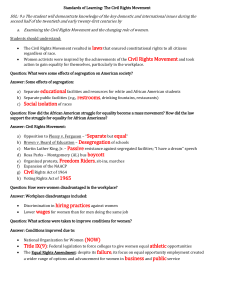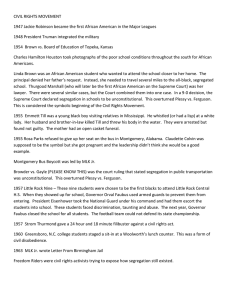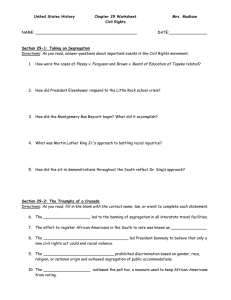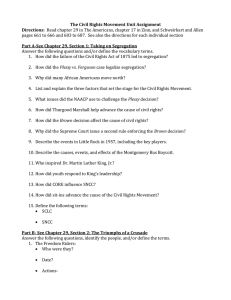Civil Rights Movement & Key Domestic Changes of the Post-WWII U.S.
advertisement
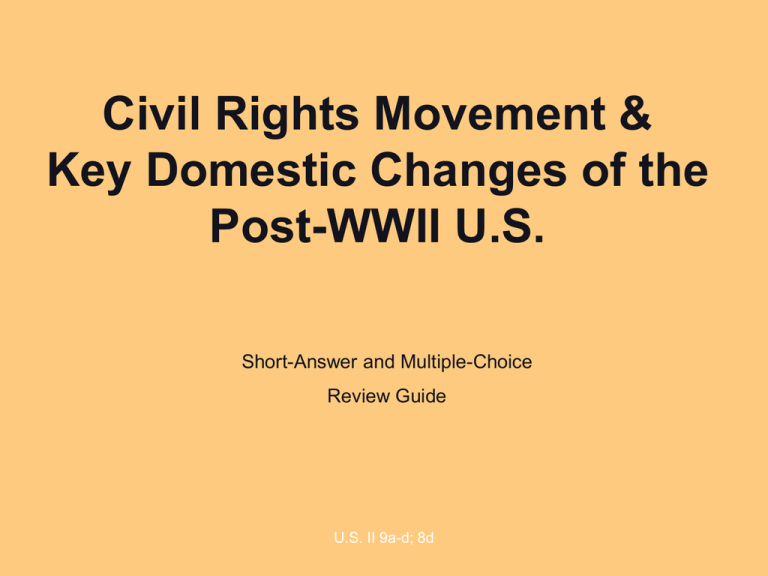
Civil Rights Movement & Key Domestic Changes of the Post-WWII U.S. Short-Answer and Multiple-Choice Review Guide U.S. II 9a-d; 8d Use the answer bank below to complete the shortanswer questions on the following slides. Then answer the multiple-choice questions. • Civil Rights Movement •Freedom Riders •ERA (Equal Rights • Voting Rights Act of Amendment) 1965 •Montgomery bus boycott • segregation •NAACP • Brown v. Board of •Booker T. Washington Education •Title IX • sit-ins •Plessy v. Ferguson • W.E.B. DuBois •Rosa Parks •women • Dr. Martin Luther King, •President Harry S Truman Jr. • National Organization of •Civil Rights Act of 1964 U.S. II 9a, b; 8d Women (NOW) #1 • Which Supreme Court case ruled that school segregation was illegal? • Which Supreme Court decision did this overturn? U.S. II 9a, b; 8d #2 • What legislation was passed in 1972 to increase equality for women’s athletics? U.S. II 9a, b; 8d #3 • Which law outlawed certain practices in the South such as poll taxes and literacy tests? U.S. II 9a, b; 8d #4 • Which president desegregated the military? U.S. II 9a, b; 8d #5 • What vocabulary word means, “to divide groups based on race”? U.S. II 9a, b; 8d #6 • In 1966, which women’s organization was created to fight for equal pay for equal work? U.S. II 9a, b; 8d #7 • To protest segregated lunch counters, many high school and college students participated in ________. U.S. II 9a, b; 8d #8 • What legislation outlawed the segregation of restaurants, hotels, and other public facilities? U.S. II 9a, b; 8d #9 • Who refused to give up her seat to a white passenger and was arrested and fined? (She is sometimes called the Mother of the Civil Rights Movement.) • What did the African American community do to protest the woman’s arrest? U.S. II 9a, b; 8d #10 • ________________ boarded Greyhound buses to protest segregated travel. U.S. II 9a, b; 8d #11 • Which amendment was designed to ban discrimination based on gender? (It failed to get enough support to pass.) U.S. II 9a, b; 8d #12 • Which organization was formed in 1909 to advance the rights and equality of African Americans? (W.E.B. DuBois was one of the early founders of this organization.) U.S. II 9a, b; 8d #13 • Which leader supported full and immediate social, civil, and political rights for African Americans? • Which leader believed equality for African Americans could be achieved through vocational training? U.S. II 9a, b; 8d #14 • Which civil rights leader supported non-violent resistance? U.S. II 9a, b; 8d #15 During which time period did the events below take place? Organized protests Marches U.S. II 9a, b; 8d Sit-ins Freedom Riders 1. What type of civil disobedience did African Americans use in 1961 to end segregation in the South? A B C D Jim Crow segregation sit-ins riots March on Washington U.S. II 9a, b; 8d Adapted from Va. Dept. of Ed. 2. What 1896 Supreme Court decision legalized Jim Crow segregation in the South? A B C D Plessy v Ferguson Gideon v Wainwright Dred Scott v Sanford Brown v Board of Education U.S. II 9a, b; 8d Adapted from Va. Dept. of Ed. 3. What was the result of the Supreme Court decision in Brown v. Board of Education? A B C D equal voting rights integration of all public facilities desegregation of public schools abolition of the poll tax U.S. II 9a, b; 8d Adapted from Va. Dept. of Ed. 4.The use of poll taxes to prevent African Americans from voting was outlawed by A B C D the Voting Rights Act of 1965. the Civil Rights Act of 1964. the 13th Amendment to the Constitution of the United States. the Patriot Act. U.S. II 9a, b; 8d Adapted from Va. Dept. of Ed. 5.The National Organization for Women was created to A B C D ensure women the right to vote. ensure that mothers have access to affordable daycare. elect more women to public office. work against gender discrimination in employment. U.S. II 9a, b; 8d Adapted from Va. Dept. of Ed. 6. Which of the following is NOT true about women in American society by the mid 1990s? A B C D Most women were paid less than men. Women had achieved full economic equality with men. Most women worked for pay outside the home. Women were underrepresented in U.S. II 9a, b; 8d public office. the area of elected Adapted from Va. Dept. of Ed.

